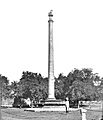Samudragupta facts for kids
Quick facts for kids Samudragupta |
|
|---|---|
| Maharajadhiraja | |

Coin of Samudragupta, with Garuda pillar, emblem of Gupta Empire. The name
|
|
| Gupta Emperor | |
| Reign | c.335-375 CE |
| Predecessor | Chandragupta I, possibly Kacha |
| Successor | Chandragupta II, or possibly Ramagupta Pataliputra |
| Spouse | Dattadevi |
| Issue | Chandragupta II, and possibly Ramagupta |
| House | Gupta dynasty |
| Father | Chandragupta I |
| Mother | Kumaradevi |
Samudragupta (Gupta script: ![]()
![]()
![]()
![]()
![]() Sa-mu-dra-gu-pta) was a powerful ruler of the Gupta Empire in ancient India. He ruled from about 350 to 375 CE. He was the son of Emperor Chandragupta I and Princess Kumaradevi. Samudragupta greatly expanded his family's power and land.
Sa-mu-dra-gu-pta) was a powerful ruler of the Gupta Empire in ancient India. He ruled from about 350 to 375 CE. He was the son of Emperor Chandragupta I and Princess Kumaradevi. Samudragupta greatly expanded his family's power and land.
He is famous for his many military victories. A special inscription, called a prashasti, tells us about his achievements. This inscription is found on the Allahabad Pillar. It was written by his court poet, Harishena.
Contents
Who Was Samudragupta?
Samudragupta was a key figure in the Gupta Empire. This empire was one of the largest and most powerful in ancient India. He took over from his father, Chandragupta I. Under Samudragupta, the empire grew much bigger.
He was not just a warrior. Samudragupta was also known for his love of poetry and music. His gold coins show him playing a musical instrument. This shows he was a well-rounded ruler.
A Great Warrior King
Samudragupta was a brilliant military leader. The Allahabad Pillar inscription describes his many conquests. He defeated many kings and brought their lands into his empire.
Conquering Northern India
He first focused on northern India. Samudragupta defeated several kings there. He then added their territories directly to his growing empire. This made the Gupta Empire much larger and stronger.
Victories in the South
After securing the north, he marched south. His armies traveled along the south-eastern coast of India. They reached as far as the Pallava kingdom. He did not always annex these southern lands. Instead, many rulers became his tributaries. This meant they paid him taxes and accepted his power.
Expanding the Empire's Reach
Samudragupta also brought many smaller kingdoms under his control. These included frontier kingdoms and tribal groups. His empire stretched far and wide. It went from the Ravi River in the west to the Brahmaputra River in the east. From the Himalayan mountains in the north, it reached central India in the south.
A Talented Ruler
To show his power, Samudragupta performed a special ceremony. This was called the Ashvamedha sacrifice. It was a horse sacrifice used by ancient Indian kings. It proved that he was the supreme ruler. His coins proudly state that he was never defeated in battle.
Samudragupta was also a talented artist. His gold coins show him as a poet and a musician. He played a stringed instrument, possibly a lyre or a veena. This shows he valued culture and arts.
His Legacy
Samudragupta's strong rule set the stage for his son. His son, Chandragupta II, continued his father's expansion plans. Samudragupta is remembered as one of India's greatest emperors. He helped the Gupta Empire reach its "Golden Age."
Images for kids
-
Text of the Allahabad stone pillar inscription of Samudragupta, in the Brahmi script.
-
A gold coin of Samudragupta
-
Commemorative type of Chandragupta I: this coin is in the name of Chandragupta I, but since no other coin types of Chandragupta are known, this is thought to be a commemorative issue minted by his son Samudragupta.
See also
 In Spanish: Samudragupta para niños
In Spanish: Samudragupta para niños








